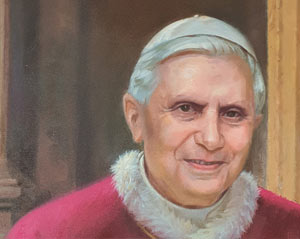The portrait is a complex genre and it is full of narrative possibilities. Progetto Arte Poli made different artworks, not just paintings, but also mosaics, stained glass windows and bronze sculptures. Last year, another oil on canvas portrait, the one dedicated to Pope Benedict XVI and realized in occasion of his 70th anniversary of ordination, began a series of original exhibition which took place in Rome, in Galleria Arte Poli. Here the artistic studio organizes exhibitions and events about liturgical art.
According to this conception, every element that is in the portrait has different meanings, the immediate one, bond to the object itself, and the symbolic one, which makes reference to the places and important events during the life of John Paul I. The audience can actively read them with his knowledge of the history of the subject.



Oil on canvas, cm 80 x 100
In the year of his beatification, this portrait depicting Pope John Paul I wants to pay homage to his figure, to his character and to the role of his pontificate, short but memorable. Painted by Master Albano Poli, founder of Progetto Arte Poli, a unique Veronese studio that makes artworks according to the traditional techniques, Pope Luciani’s portrait is like a representation of the psychological aspects, places, passions and the main stages of his life. It is an old idea that was first used during the early Renaissance, when the portrait genre was born and the most important and influential people began to be memorable. Progetto Arte Poli becomes a witness and a prosecutor of this great tradition which links the painting to the study and research, to the knowledge of the main phases during the life of the main character that has to be portrayed in order to give back to the audience a meaningful representation.
The portrait

1. The bookcase
Other important elements are the friezes of the bookcase, where we can see the reference to the gestatorial chair. On the shelves there are the books he wrote: “Catechetica in Briciole” and “Illustrissimi, lettere ai grandi del passato”. The ancient pharmacy’s vase has his motto “Humilitas”, the humility as a remedy, a cure and quality that is necessary for who is called to the service of authority. Between his books, we can see a blank paper, which recalls the interrupted Pontificate few days before the election.
2. The landscape
A particular effect is given by the landscape on the background, with the mountains of his hometown. You can notice that the frame of the painted landscape is the same of the portrait itself, like a mise en abyme that can be interpretated as a dialogue between two of the most important painting genres, the landscape and the portrait.
3. The winged lion
The winged lion, another element which is in his coat of arms, here placed on the top of a column that trace the ones in St.Mark Square, with the book open with the words “Pax Tibi Marce Evangelista Meus” which recalls the time when Pope Luciani was Patriarch of Venice.
Other important elements are the friezes of the bookcase, where we can see the reference to the gestatorial chair. On the shelves there are the books he wrote: “Catechetica in Briciole” and “Illustrissimi, lettere ai grandi del passato”. The ancient pharmacy’s vase has his motto “Humilitas”, the humility as a remedy, a cure and quality that is necessary for who is called to the service of authority. Between his books, we can see a blank paper, which recalls the interrupted Pontificate few days before the election.
2. The landscape
A particular effect is given by the landscape on the background, with the mountains of his hometown. You can notice that the frame of the painted landscape is the same of the portrait itself, like a mise en abyme that can be interpretated as a dialogue between two of the most important painting genres, the landscape and the portrait.
3. The winged lion
The winged lion, another element which is in his coat of arms, here placed on the top of a column that trace the ones in St.Mark Square, with the book open with the words “Pax Tibi Marce Evangelista Meus” which recalls the time when Pope Luciani was Patriarch of Venice.
4. The pectoral cross
The pectoral cross, which reproduces faithfully the “Christ of Hope”, is a bronze sculpture designed and realized by Albano Poli in 2013 according to the Pontifical Council for the Pastoral Care of Health Care Workers. It is a picture of a crucified Jesus who doesn’t suffer anymore, who seems to rise from the cross, which seems to dissolve. The ministry wanted to promote and bring this symbol in hospitals, in care facilities and wherever the mysteries of sufferance, life and hope are celebrated. Putting this cross in the portrait takes the value of a wanted anachronism, a posthumous homage that Progetto Arte Poli wanted to dedicate to the Smiling Pope, remembered by the people for his humility, as he wanted. “I am the child I was, I am the one who comes from the land, I am the pure and poor dust; on this dust, God wrote”. (Albino Luciani, 1959)
5. The three stars
The realization of the portrait began from the study and analysis of the papal coat of arms in order to make reference to the symbols in the composition. The three stars depicted on the chair are the ones of his papal coat of arms, which recall the theological virtues and the theme of light, with a direct reference to his surname.
The pectoral cross, which reproduces faithfully the “Christ of Hope”, is a bronze sculpture designed and realized by Albano Poli in 2013 according to the Pontifical Council for the Pastoral Care of Health Care Workers. It is a picture of a crucified Jesus who doesn’t suffer anymore, who seems to rise from the cross, which seems to dissolve. The ministry wanted to promote and bring this symbol in hospitals, in care facilities and wherever the mysteries of sufferance, life and hope are celebrated. Putting this cross in the portrait takes the value of a wanted anachronism, a posthumous homage that Progetto Arte Poli wanted to dedicate to the Smiling Pope, remembered by the people for his humility, as he wanted. “I am the child I was, I am the one who comes from the land, I am the pure and poor dust; on this dust, God wrote”. (Albino Luciani, 1959)
5. The three stars
The realization of the portrait began from the study and analysis of the papal coat of arms in order to make reference to the symbols in the composition. The three stars depicted on the chair are the ones of his papal coat of arms, which recall the theological virtues and the theme of light, with a direct reference to his surname.











